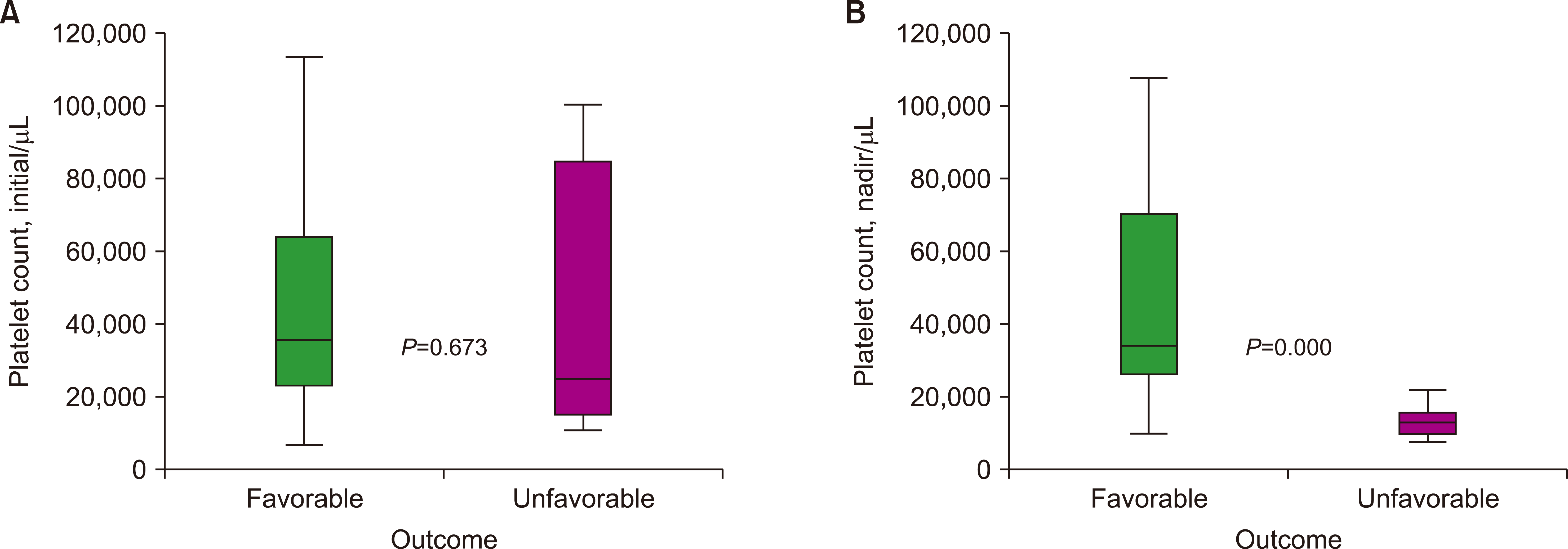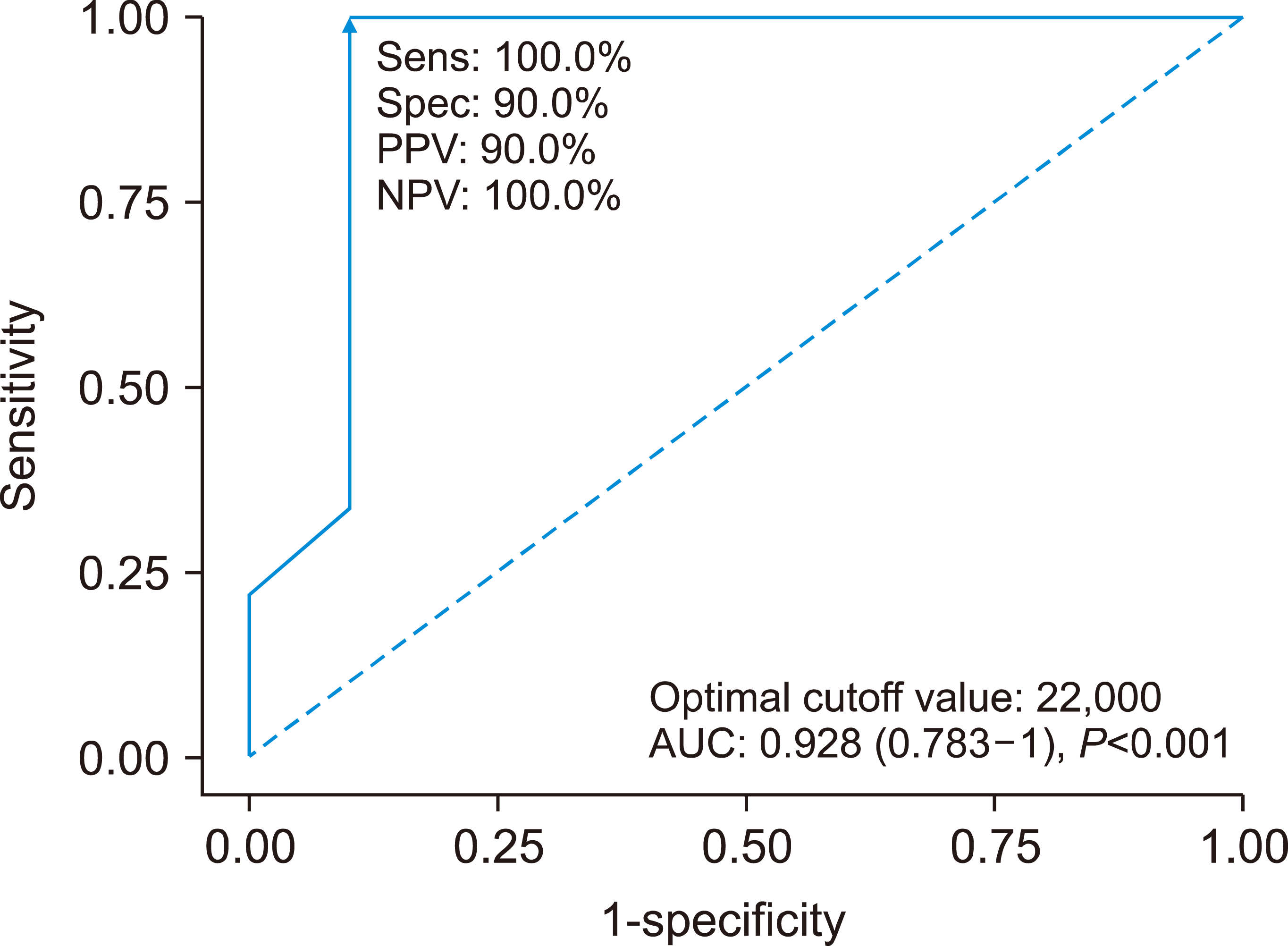Acknowledgments
Notes
REFERENCES
Fig. 1

Fig. 2

Table 1
| Patient No. | Age, years | Sex | Symptom onset (N of days after vaccination) | Symptoms | CVT | Splan-chnic vein throm-bosisa) | Pulm-onary embo-lism | Other throm-bosis or hemorr-hage | Platelet initial (per mL) | Platelet nadir (per mL) | D-dimer, peak (mg/L) | INR peak | PTT peak (sec) | Fibrino-gen nadir (mg/dL) | PF4–heparin ELISA (optical density) | Heparin treatment | Other medical conditions | Outcome |
|---|---|---|---|---|---|---|---|---|---|---|---|---|---|---|---|---|---|---|
| Korean 1 | 33 | M | 11 | Headache, seizure | Yes | No | No | Cerebral hemorrhage | 77,000 | 65,000 | >20 | 1.01 | 35.7 | 197.9 | 3.10 | No | ACL-Ab | Full recovery |
| Korean 2 | 33 | M | 8 | Headache, hemiparesis, drowsiness | Yes | No | No | Cerebral hemorrhage | 14,000 | 10,000 | >35.2 | 1.51 | 60.7 | 77 | 0.72 | No | No | Fatal |
| Ref 1-1 | NA | NA | 5 | Chills, fever, nausea, and epigastric discomfort | Yes | Yes | Yes | Aortoiliac artery thrombosis | NA | 13,000 | 142 | 1.4 | 41.6 | 78 | 3.16 | Yes | No | Fatal |
| Ref 1-2 | NA | NA | 6 | NA | No | No | Yes | No | NA | 107,000 | 1.8 | 1.12 | 29 | 568 | 3.08 | LMWHe) | No | Recovering |
| Ref 1-3 | NA | NA | 9 | NA | Yes | No | No | No | NA | 60,000 | 13 | NA | NA | NA | 3.5 | Unknown | No | Unknown |
| Ref 1-4 | NA | NA | 7 | NA | Yes | No | No | No | NA | 9,000 | NA | 1.66 | 46.6 | NA | 3.4 | Yes | CND | Fatal |
| Ref 1-5 | NA | NA | 13 | NA | Yes | Yes | Yes | Right intra-ventricular, iliofemoral vein, IVC thrombi | NA | 23,000 | NA | 1.25 | 64.8 | 173 | 1.2 | Yes | VWD-I; FVL; ACL-Abs | Recovering |
| Ref 1-6 | NA | NA | 7 | NA | Yes | No | No | No | NA | 75,000 | 2.6 | 1.05 | 23 | NA | NA | Unknown | No | Recovering |
| Ref 1-7 | NA | NA | 8 | NA | Yes | No | No | No | NA | 29,000 | >33.0 | 1.34 | 45 | 210 | NA | Yes | No | Recovering |
| Ref 1-8 | NA | NA | 8 | NA | Yes | No | No | Widespread microvascular thrombi (brain, lungs, and kidneys)d) | NA | 16,000 | NA | NA | NA | NA | 2.02 | No | No | Fatal |
| Ref 1-9 | NA | NA | 16 | NA | Yes | No | No | Multiple organ thrombid) | NA | 13,000 | 21 | 1.7 | 46.1 | 40 | 3.51 | No | No | Fatal |
| Ref 1-10 | NA | NA | 11 | NA | Yes | Yes | No | No | NA | 8,000 | >35.0 | NA | NA | 80 | 2.35 | No | No | Fatal |
| Ref 1-11 | NA | NA | 12b) | NA | Pendingc) | No | No | Cerebral hemorrhagec) | NA | NA | NA | NA | NA | NA | 2.16 | No | Unknown | Fatal |
| Ref 4-1 | 37 | F | 8 | Fever, headache, visual disturbances | Yes | No | No | No | NA | 22,000 | >35 | 1.2 | 25 | 210 | 3.7 | Initial low dose of LMWH | NA | Fatal |
| Ref 4-2 | 42 | F | 10 | Headache, drowsiness | Yes | No | No | No | NA | 14,000 | >35 | 1 | 31 | 80 | 35.93.4 | Reduced dose of LMWH | NA | Fatal |
| Ref 4-3 | 32 | M | 7 | Back pain | No | Yes | No | Azygos vein, hemiazygos vein, and several basivertebral veins’ thrombi | NA | 10,000 | >35 | 1.1 | 25 | 230 | 3.6 | Reduced dose of LMWH | NA | Full recovery |
| Ref 4-4 | 39 | F | 10 | Headache, abdominal pain | Yes | No | No | No | NA | 70,000 | 13 | 1.3 | 25 | 120 | 3.8 | Reduced dose of LMWH | NA | Full recovery |
| Ref 4-5 | 54 | F | 7 | Headache, hemiparesis | Yes | No | No | No | NA | 19,000 | >35 | 1.1 | 29 | 120 | 2.9 | Heparin (5,000 IU) | NA | Fatal |
| Ref 5-1 | 30 | F | 13 | NA | Yes | Yes | Yes | Ischemic bowel with infarction | 27,000 | NA | NA | NA | NA | NA | Pos | NA | NA | Survived |
| Ref 5-2 | 55 | F | 6 | NA | No | Yes | No | Acute aortic thrombosis and cerebral hemorrhage | 11,000 | NA | NA | NA | NA | NA | Pos | NA | NA | Died |
| Ref 5-3 | 26 | F | 12 | NA | Yes | No | No | No | 64,000 | NA | NA | NA | NA | NA | 2.45 | NA | NA | Survived |
| Ref 5-4 | 52 | F | 10 | NA | Yesd) | No | Yesd) | Cerebral hemorrhaged) | 31,000 | NA | NA | NA | NA | NA | 2.26 | NA | NA | Died |
| Ref 5-5 | 38 | M | 14 | NA | No | No | Yes | No | 16,000 | NA | NA | NA | NA | NA | 2.84 | NA | NA | Died |
| Ref 5-6 | 49 | F | 15 | NA | Yes | No | Yes | Cerebral hemorrhage | 14,000 | NA | NA | NA | NA | NA | Pos | NA | NA | Survived |
| Ref 5-7 | 25 | M | 9 | NA | Yes | No | No | No | 19,000 | NA | NA | NA | NA | NA | Pos | NA | NA | Died |
| Ref 5-8 | 32 | M | 19 | NA | Yes | No | No | No | 87,000 | NA | NA | NA | NA | NA | Pos | NA | NA | Survived |
| Ref 5-9 | 35 | F | 9 | NA | Yes | No | No | No | 65,000 | NA | NA | NA | NA | NA | Pos | NA | NA | Survived |
| Ref 5-10 | 77 | M | 8 | NA | No | No | Yes | No | NA | NA | NA | NA | NA | NA | Pos | NA | NA | Survived |
| Ref 5-11 | 66 | M | 12 | NA | No | No | No | Deep vein thrombosis, adrenal hemorrhage | 34,000 | NA | NA | NA | NA | NA | Pos | NA | NA | Survived |
| Ref 5-12 | 34 | M | 14 | NA | Yes | No | No | No | 23,000 | NA | NA | NA | NA | NA | Pos | NA | NA | Survived |
| Ref 5-13 | 54 | M | 10 | NA | No | Yes | No | Myocardial infarction | 71,000 | NA | NA | NA | NA | NA | 0.76 | NA | NA | Died |
| Ref 5-14 | 71 | F | 14 | NA | No | No | No | Hemorrhagic symptoms only | 17,000 | NA | NA | NA | NA | NA | Pos | NA | NA | Survived |
| Ref 5-15 | 22 | F | 10 | NA | Yes | No | No | Cerebral hemorrhage | 100,000 | NA | NA | NA | NA | NA | 1.4 | NA | NA | Died |
| Ref 5-16 | 39 | F | 10 | NA | No | No | No | Cerebral infarction | 57,000 | NA | NA | NA | NA | NA | 1.4 | NA | NA | Survived |
| Ref 5-17 | 70 | F | 17 | NA | No | No | Yes | Deep vein thrombosis | 28,000 | NA | NA | NA | NA | NA | Pos | NA | NA | Survived |
| Ref 5-18 | 21 | M | 10 | NA | No | No | No | Cerebral infarction | 113,000 | NA | NA | NA | NA | NA | 2.8 | NA | NA | Survived |
| Ref 5-19 | 46 | F | 14 | NA | Yes | No | No | No | 7,000 | NA | NA | NA | NA | NA | >3.00 | NA | NA | Survived |
| Ref 5-20 | 32 | F | 12 | NA | Yes | No | No | No | 98,000 | NA | NA | NA | NA | NA | 2.17 | NA | NA | Died |
| Ref 5-21 | 48 | M | 14 | NA | Yes | No | No | No | 16,000 | NA | NA | NA | NA | NA | 2.45 | NA | NA | Survived |
| Ref 5-22 | 49 | F | 24 | NA | No | No | Yes | No | 61,000 | NA | NA | NA | NA | NA | >3.00 | NA | NA | Survived |
| Ref 6-1 | 72 | F | 7 | Leg pain, claudication | No | No | No | Peripheral artery thromboses | 36,000 | 39,000 | >20 | NA | NA | 237 | 2.70 | Yes | NA | Full recovery |
| Ref 6-2 | 63 | M | 18 | Leg clamping | No | No | Yes | Peripheral artery thromboses, deep vein thrombosis | 36,000 | 26,000 | >10 | 1.3 | NA | 140 | 1.78 | Yes | NA | Full recovery |
| Ref 6-3 | 69 | M | 12 | Headache, confusion | Yes | Yes | Yes | Cerebral infarction, internal jugular vein thrombosis | 35,000 | 29,000 | 3.35 | 1.4 | NA | 210 | 2.69 | No | NA | Recovering |
a)Splanchnic-vein thrombosis indicates thrombosis of the portal, mesenteric, splenic, or hepatic veins.
e)Treatment with low-molecular-weight heparin was associated with clinical improvement and increasing platelet counts (107,000 to 132,000 over 3 days). The patient’s drug was then switched to a direct oral anticoagulant when the ELISA showed positive results for antibodies against PF4–heparin, with further clinical and platelet-count recovery.
Abbreviations: ACL-Abs, anticardiolipinantibodies; CVT, cerebral venous (sinus) thrombosis of the cortical vein; ELISA, enzyme-linked immunosorbent assay; F, female; FVL, factor V Leiden; INR,




 PDF
PDF Citation
Citation Print
Print


 XML Download
XML Download